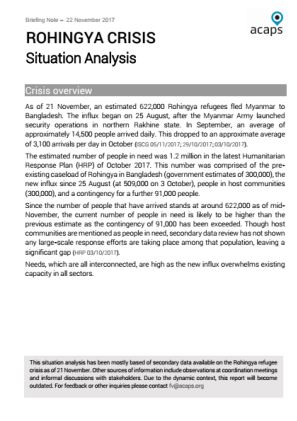-
Countries
-
Data and Analysis
-
Special Focus
-
Crisis Responses
Bangladesh — Rohingya Crisis — Situation Analysis Report (22 November 2017

Contacter
NPM Bangladesh, NPMBangladesh@iom,int
Langue
English
Emplacement
Bangladesh
Snapshot Date
Nov 21 2017
Activité
- Other
- Mobility Tracking
- Baseline Assessment
As of 21 November, an estimated 622,000 Rohingya refugees fled Myanmar to Bangladesh. The influx began on 25 August, after the Myanmar Army launched security operations in northern Rakhine state. In September, an average of approximately 14,500 people arrived daily. This dropped to an approximate average of 3,100 arrivals per day in October. Current key challenges include the following: Congestion is a threat to health and is complicating response. A highpopulation density in the settlements means limited land is available to buildfacilities for the refugee population. Existing facilities are overwhelmed. WASH remains of high concern, as faecal contamination of drinking water ishigh. Disease outbreak, including acute watery diarrhoea, remains likely – adangerous combination with very high malnutrition rates. The ongoing measles outbreak is of concern, again particularly incombination with very high malnutrition rates. The latest SMART survey inKutupalong refugee camp shows global acute malnutrition rates of 24%. The humanitarian community has limited time to scale up response prior tothe cyclone season (April–June). This will significantly compound reliefefforts, and increase the risk of disease outbreak. Existing shelters are unableto withstand cyclones. Measures to prevent long-term full aid dependency are needed. This isparticularly challenging as Rohingya are limited in their freedom ofmovement and livelihood opportunities. Psychosocial support as many refugees have experienced trauma includingtorture and rape. Living in crowded and unsanitary conditions are additionalstressors. Access to fuel is a key concern. Rohingya have reported selling of foodrations to obtain firewood. When collecting firewood in the forests, they areexposed to a wide range of protection concerns. Cooking with firewoodinside shelters is a significant fire hazard. Women and girls have additional needs due to societal norms and culturalpractice.
